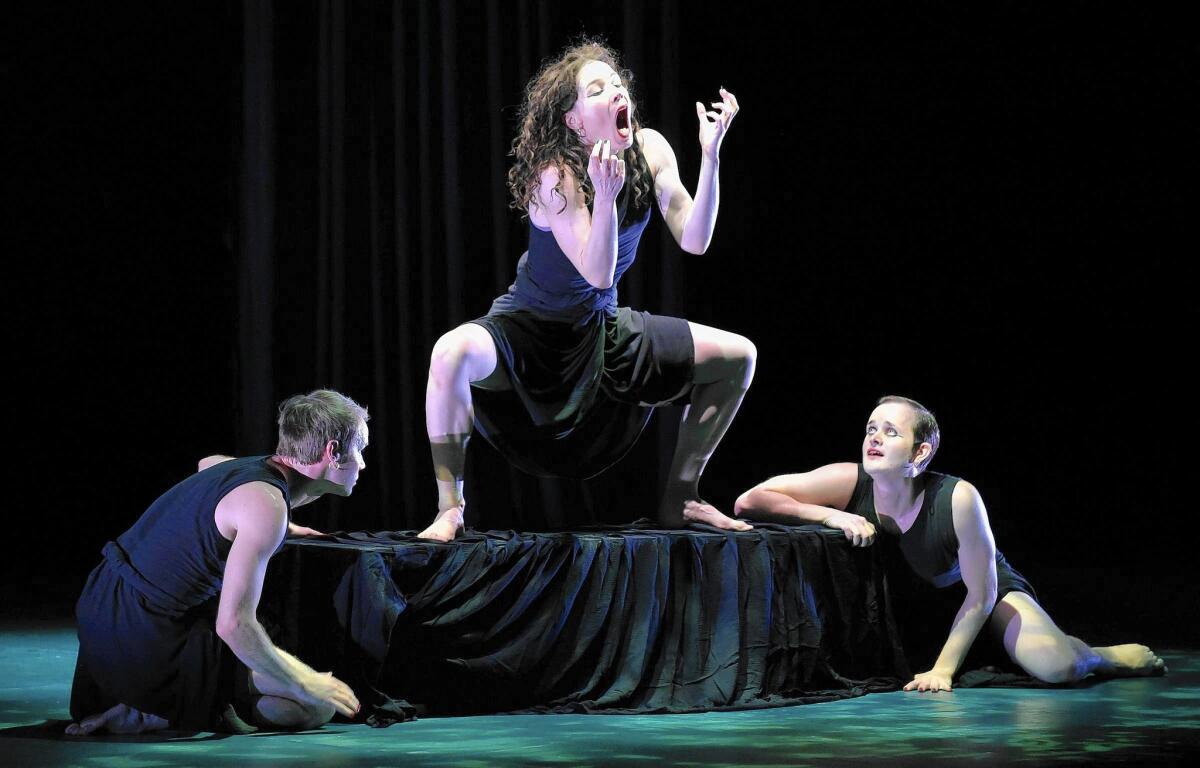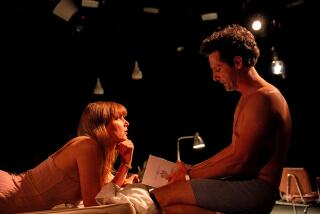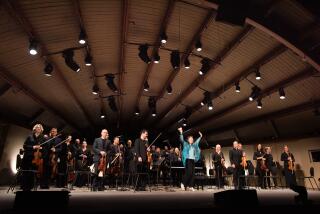Review: Mark Morris’ ‘Dido and Aeneas’ an exuberant spin on ancient epic

Members of the Mark Morris Dance Group perform “Dido and Aeneas,” a partial retelling of Virgil’s epic poem “Aeneid,” at the Irvine Barclay Theatre.
- Share via
Mark Morris’ danced opera “Dido and Aeneas” is a tour de force of late 20th century artistic storytelling, a partial retelling of Virgil’s 2,000-year-old epic poem “Aeneid” using Henry Purcell’s 1689 musical composition. It is a riveting assemblage, one that smashes and rewrites stylistic boundaries.
The hour-long piece over the weekend had only its second local engagement at the Irvine Barclay Theatre, presented by the Philharmonic Society of Orange County.
For years after the 1989 premiere of “Dido,” Morris portrayed the work’s signature oppositional roles of good Queen Dido and the evil Sorceress. On Friday evening, the musically keen choreographer was in the pit conducting Los Angeles’ outstanding Musica Angelica Baroque Orchestra, five excellent soloists and the marvelous Bob Cole Conservatory Chamber Choir from Cal State Long Beach.
Twelve members of the Brooklyn-based Mark Morris Dance Group took on multiple characters in this tale of the Carthaginian monarch and her consuming love for the Trojan hero who is journeying to Rome. Aside from the two leads, the dancers are like roving troubadours, breaking the fourth wall as they shape-shift into different parts, “commenting” on what’s taking place through movements both dignified and grotesque, and then reeling us in through emotional exuberance.
Mezzo-soprano Jamie Van Eyck sang both the Dido and Sorceress roles, impressing with her shimmery and aching vibrato. The onstage Dido and Sorceress was dancer Laurel Lynch, a statuesque beauty. Her long, curly hair was tied up for Dido, the unruly locks down in her face for the Sorceress. Making the characterizations real, however, took more than a change in hairstyle.
Lynch’s Dido was restrained at first, a bit of a blank slate, as she focused on the Queen’s exacting positions. She loosened up in her duets with Aeneas. Though models of courtly decorum, they still crackled like fire. When he came to say goodbye, Lynch swept her arm upward on the words “Away, away!,” and the force of the gesture was the equivalent of a slap. She transformed her lean line into a full-bodied coarseness while playing the Sorceress.
Bass-baritone Douglas Williams sang Aeneas with a sumptuous quality, matched by the dancer-Aeneas, Domingo Estrada Jr.
Morris does not generally cast his works based on a dancer’s looks; indeed, he likes to play against type. But here, the physical appearance of Dido and Aeneas is critical — even when Morris improbably switches the genders of the dancers. Estrada, broad-shouldered, bare-chested and devilishly handsome, was matinee-idol perfection. He projected authority and mischievousness, as when he threw a knowing wink to the audience after he won over Dido and she led him offstage for loving rewards.
The secondary roles were also enchantingly sung and danced: Michelle Yard as Dido’s too-helpful sister Belinda (soprano Sherezade Panthaki) and Rita Donahue as the sidekick Second Woman (Marguerite Krull in the soprano part). Mark Morris veteran Lauren Grant led the sailors in a jolly Irish step dance and jig (sung by Andrew Konopak). Noah Vinson and Dallas McMurray made hilarious scoundrels, heeding the Sorceress as her henchmen-witches (sung by Panthaki and Krull).
Morris makes a remarkably small production feel epic, as befitting an ancient myth. Robert Bordo’s set is spare: several low balustrades, sheets of black hanging cloth and a backdrop that’s an abstract map of Aeneas’ journey. The dancers wore draped black balloon pants and fitted tops, designed by Christine Van Loon.
Yet with great nuance and variety, Morris culls from his vast movement knowledge to create ancient-looking friezes, lines that surge like waves and classical Indian poses. The piece begins and ends with solemn promenades. Several scenes conclude with dancers pounding their feet against the floor to create a rumbling hailstorm that portends the tragic finale.
Musica Angelica and two guest artists from the Morris music ensemble made their own fireworks. When everyone joined together — musicians, singers, dancers — it proved, yet again, that you didn’t need a movie screen to make a blockbuster.
More to Read
The biggest entertainment stories
Get our big stories about Hollywood, film, television, music, arts, culture and more right in your inbox as soon as they publish.
You may occasionally receive promotional content from the Los Angeles Times.










